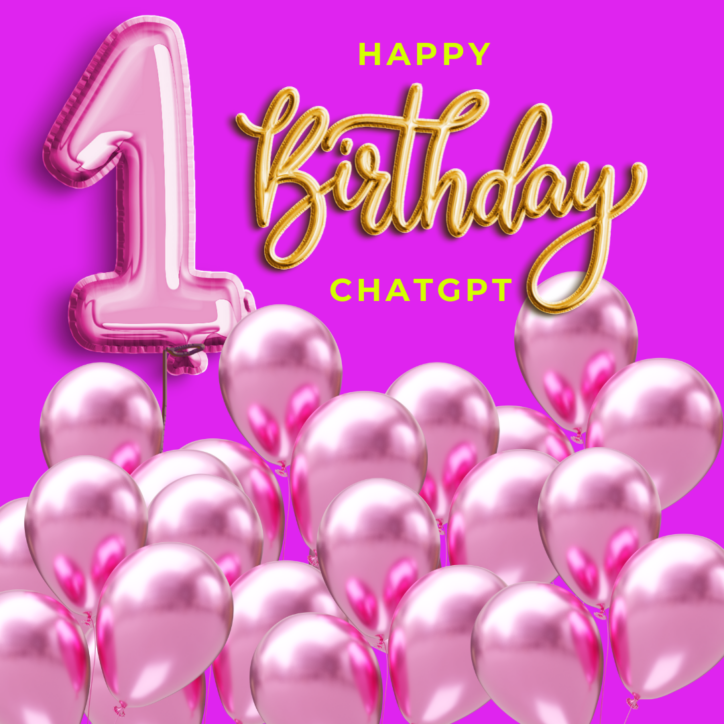ChatGPT 1-Year Anniversary & 2023 Explosive OpenAI Milestones

It’s been a whirlwind year for generative artificial intelligence (GenAI), and we’re only just getting started. It seems hard to believe that we managed to fit so much progress into just 365 days, but here we are, the anniversary of OpenAI releasing ChatGPT to the world. Just as impressive as the technology itself is how A.I. has already tangled itself into every corner of our culture, from entertainment to business, government, politics, and even romance.
It’s not a stretch to say that, for better or worse, we are witnessing a historic shift in human trajectory. Yet, the lightning pace of daily A.I. breakthroughs has made it hard for the casual observer to keep up.
So before we ring in a new year, Creativity Squared is commemorating ChatGPT’s first birthday with a retrospective of OpenAI’s defining moments in 2023.

Breaking the Internet
OpenAI launched ChatGPT to the public on November 30, 2022. In fairness, ChatGPT is actually closer to five years old. The first iteration was released in 2018, followed by GPT-2 the next year and ChatGPT-3 in 2020. But A.I. didn’t explode into the cultural zeitgeist until OpenAI refined GPT-3 into GPT-3.5 and put it in a web browser for the world to experience.
“Explode” is even an understatement compared to the success of other digital products. Within two months of going live online, ChatGPT had over 100 million monthly active users. ChatGPT’s adoption rate set a new record for the fastest-growing user base in the history of tech platforms. By comparison, TikTok took nine months to reach the same milestone, and Instagram took twice as long as that.
ChatGPT’s success set off a frenzy at all levels of the economy. Hundreds of new apps were built around ChatGPT in the blink of an eye, every major business suddenly had a new A.I. announcement, tech industry behemoths like Google went frantic trying to ship their own GPT competitors, investors ignored historic returns on U.S. Treasury bonds to speculate on A.I. startups, and a new class of A.I. content creators was born.
Shortly after GPT-3 kicked off the A.I. revolution, OpenAI released GPT-4, which boasted significant improvement in creativity, advanced reasoning and code interpretation. GPT-4 also endowed the model with real-time information by enabling it to search through Bing. The capabilities of GPT-4 helped cement A.I. as a capable assistant for a wide variety of professional applications, which legitimized A.I. as a mission-critical productivity tool.
GPT-4 also inspired a backlash from those who fear the worst outcomes of advanced artificial intelligence. Over 1,110 people, including Tristan Harris and Elon Musk, signed an open letter calling on the government and/or A.I. developers to institute a six-month pause in building A.I. models more advanced than GPT-4. The letter asked whether we should be developing nonhuman minds that may eventually replace us, and asserted that such decisions should not be “delegated to unelected tech leaders.” In response to the letter, OpenAI said in March that it doubled down on safety training for GPT-4 and claimed at the time that it was not currently training GPT-5. While the call for a pause did not yield the results that the signatories wanted, it did raise the public’s consciousness of the existential risks associated with A.I. and the need for greater public scrutiny.
DALL-E Designs a Short Film
This year also saw A.I. turn the world of art, entertainment, and content creation on its head. OpenAI’s DALL-E enabled anyone with an image in their mind to bring it into reality merely by writing their thoughts into a text box. Subsequent A.I. products like Adobe Firefly, Canva Magic, Runway, and others have further collapsed the skill gap between professionals and aspiring artists.
One of the biggest trends to emerge from A.I. image generation this year was mashing-up aesthetics in pop culture: Harry Potter characters if they were Balenciaga models, Lord of the Rings directed by Wes Anderson, and countless other examples where A.I. essentially furthered the democratization of creativity and enabled anyone to participate in a collective online art project.
Despite attempts by A.I. developers to mitigate harmful image generation, this year also offered early glimpses at how the technology can be used for deception. The most viral example in the U.S. so far, luckily, was a lighthearted send-up of the Pope in a white puffer jacket.
Text-to-video generation is getting better as well. This Spring, animated filmmaker Chad Nelson released Critterz, the first animated short whose imagery was entirely generated with DALL-E. Although the film was not entirely produced by A.I., all of the characters and backgrounds were generated by text-to-image. The ability to rapidly generate and tweak multiple different visualizations significantly quickened the production timeline, showing A.I.’s utility as a creative assistant even if it isn’t advanced enough yet to make a full film from scratch. Disney Executive and Dreamworks Co-Founder, Jeffrey Katzenberg, told the press earlier this month that he expects A.I. will drive down the cost of producing animated films by 90 percent.
Sam Altman’s Ouster
The fate of OpenAI briefly hung in the balance in the days leading up to Thanksgiving, after the Board of Directors announced in a vague press release that they were firing Sam Altman. The release claimed that Altman was fired for being less than “candid” with the board about an undisclosed matter. Rumors immediately started flying around social media speculating that OpenAI achieved artificial general intelligence without the board’s knowledge. Others chalked up the ouster to personal politics, jealousy of Altman’s public profile, or corporate sabotage by board members with an ax to grind.
Over the course of five days, mayhem ensued, unlike anything we’ve seen since Apple’s board fired Steve Jobs. OpenAI co-founder and Chairman of OpenAI’s Board, Greg Brockman, said he was cut out of the decision to fire Altman and resigned in solidarity shortly after the news broke. Microsoft, OpenAI’s biggest investor, was also in the dark until close to when the announcement was released. Microsoft CEO Satya Nadella quickly made a short-lived deal to set up a new in-house A.I. shop for Altman and Brockman to run. On top of this, over 700 of OpenAI’s 770 employees threatened to leave en masse if the board didn’t quit and re-instate Sam, putting OpenAI on the verge a potential collapse. Ilya Sutskever, OpenAI Chief Scientist and co-founder voted to remove Sam, but then shared that he regretted the decision and switched sides. The drama also included Salesforce CEO Marc Benioff publishing recruiting blasts on X, offering to salary match any OpenAI engineer who wanted to jump ship.
By the Tuesday before Thanksgiving, November 21, the OpenAI board had tried and failed to replace Altman with at least two other candidates, and Sam and Greg were back at OpenAI to continue OpenAI’s mission to achieve artificial general intelligence. The board was overhauled. Helen Toner, Tasha McCauley, and Ilya Sutskever left the board, and Adam D’Angelo, the CEO of Quora who was one of the board directors who had voted to fire Sam Altman, is the only board member who is staying. Bret Taylor, an early Facebook executive and former executive of Salesforce, joined the board as the new chairman in addition to Larry Summers, the former Treasury Secretary.
The saga put a fine point on the inherent risks of OpenAI’s unusual structure where a nonprofit controls a for-profit entity. The episode also illustrates the intoxicating allure of the power associated with directing advanced A.I. development. Who can be trusted at the helm of A.I. without abusing the position for their own gain? Should any one person have that power or should such decisions be made democratically? And how do we balance the public’s right to scrutinize the people and policies affecting our lives with the privacy rights of companies and individuals? While the exact circumstances of Altman’s initial ouster remain unclear, the employees of OpenAI, the stock market, and Silicon Valley seem relieved that Altman is back in control.
Riding the A.I. Bullet Train
The upshot of all the breakthrough A.I. developments this year is the increasing pace of progress and the compression of time. A.I. has blown past benchmarks in reasoning, natural language processing, gaming, comprehension, abstraction, and analysis faster than even the majority of experts predicted. The pace will only pick up from here. Blink at the wrong time in 2024, and you might miss a paradigm shift in human progress. As many of Creativity Squared’s guests have advised this year, the time to start familiarizing yourself with A.I. is now.
Culture & Code Host John Gauntt says in this week’s episode that creatives will be the canaries in the coalmine at the forefront of many of the good and bad changes to come from artificial intelligence. So creatives should start preparing now for a rapidly shifting landscape over the coming years. Creativity Squared will be along for the rollercoaster ride, bringing the conversations and information that creatives need to not only survive, but thrive in the A.I. revolution that is here and not slowing down.
